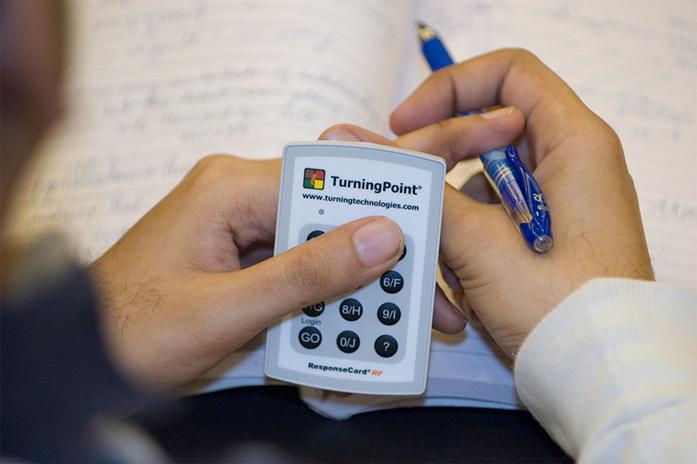New clicker system receives mixed reactions from students and staff.
By Madeleine Neal
madeleine-neal@uiowa.edu
A lecture hall is filled with hundreds of students and one way for the professor to interact with sll of them is through clickers.
To University of Iowa Associate Professor Jasper Halekas, student-response systems, less formally known as clickers, are helpful.
However, this semester, interactions have changed, with TurningPoint “cloud” being used instead of TurningPoint “software” or the physical clickers.
On the UI Information Technology Service website, clickers are said to “allow students to enter responses via a small wireless device that records responses through software to the instructor station in a classroom.”
The use of wireless devices is intended to “make classes more interactive and fun, facilitate discussions, guide lectures, encourage peer instruction, and conduct polls,” the website said. “They’re used to review for quizzes and tests, direct classroom discussions, and provide feedback on course material.”
The website said that the objective of the switch is to “beef up security, allow new features, and merge with ICON — and require a lighter load for students to physically carry.”
Students who already own clickers will not be charged for the new format of the clickers.
“Students will be able to turn in their clickers in the fall in exchange for a one-, two-, or three-year license from TurningPoint depending on what their class is,” the website said.
In other words, other devices are permitted.
“Instead of bringing separate clicker devices to class as they have in the past, they’ll be able to use other wireless-enabled personal devices — like laptops, tablets, or cellphones,” the website said.
Halekas, who uses clickers in his physics course, said the technology is a good mode of feedback.
“[Using clickers] allows you to break up the class,” he said. “We are able to get a response.”
Of course, many UI students find positives in clickers, including UI senior David Lewis.
“I liked [clickers] — they are generally easy questions,” he said. “They make sure you’re paying attention in a lecture.”
The positive reactions coincide with the old use of clickers, however. Halekas said students might be prone to distraction when using their phones, tablets, or laptops.
“The old style worked very well; this year, we’re switching to students bringing their own [devices],” he said. “This could be less popular with students.”
UI sophomore Matt Wallack said the clickers worked properly. However, for him, his professors used the clickers for attendance rather than for educational purposes. Wallack noted that he could be counted absent for showing up late to class after the clickers had already been used, which he did not like.
“They functioned properly,” he said. “I just wish it wasn’t used for attendance.”
The intent of the clickers, according to the ITS website, is much different from simply collecting attendance.
“[Clickers are] used to review for quizzes and tests, direct classroom discussions, and provide feedback on course material,” the website said.
Halekas acknowledged the effectiveness of the student response system, if it is used properly.
“If used correctly, they are fun — if you do them right to incorporate discussion — they make lecture more fun,” he said.



